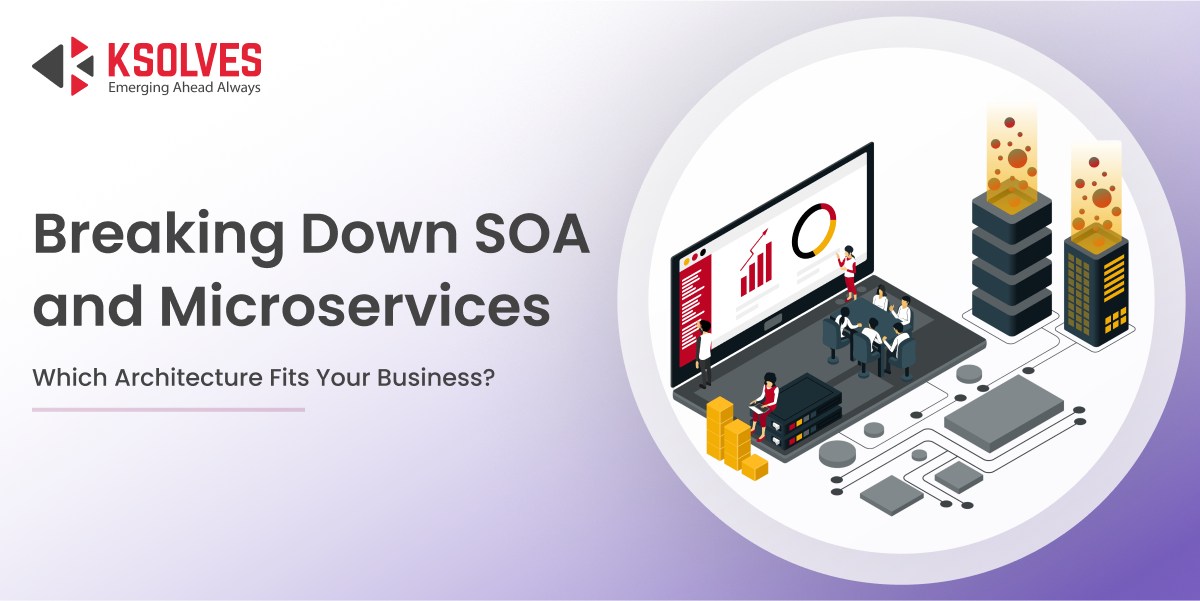Top 10 Benefits of Microservices: How Modern Architecture Boosts Business Agility
Microservices
5 MIN READ
November 21, 2025
![]()

In the ever-evolving landscape of software development, the shift from monolithic architectures to microservices has been nothing short of revolutionary. What was once a complex, tightly-coupled system is now being transformed into a collection of agile, independently deployable services.
This transition is not merely a trend but a strategic move by organizations aiming to enhance scalability, resilience, and speed in their application development processes.
In this blog, we will walk you through some of the top benefits of microservices architecture, illustrating how this modern approach can streamline development, enhance operational efficiency, and drive business growth.
The Surge in Microservices Adoption
The adoption of microservices has seen a significant uptick in recent years. According to a 2024 survey by Solo.io, nearly 85% of enterprises have already embraced microservices architecture, indicating a substantial move away from traditional monolithic systems. Furthermore, the global microservices architecture market was valued at USD 4.2 billion in 2024 and is projected to reach USD 13.1 billion by 2033, exhibiting a growth rate of 12.7% during 2025-2033.
This surge is driven by the need for more flexible, scalable, and resilient systems that can keep pace with the demands of modern business operations.
What Sets Microservices Apart?
At the heart of microservices lies the principle of decomposition, which means breaking down applications into smaller, self-contained services that can be developed, deployed, and scaled independently. Each service corresponds to a specific business function and communicates with others through well-defined APIs.
This modular approach offers several advantages over traditional monolithic architectures, including:
- Independent Scalability: Scale only the components that require more resources, optimizing performance and cost.
- Faster Time-to-Market: Enable continuous delivery and deployment, accelerating the release of new features.
- Enhanced Fault Isolation: Isolate failures to individual services, preventing system-wide outages.
- Technology Agnosticism: Allow the use of different technologies and frameworks best suited for each service’s requirements.
These characteristics make microservices an attractive choice for organizations looking to modernize their application architectures and stay competitive in a fast-paced digital landscape.
Top 10 Benefits of Microservices Architecture
1. Enhanced Scalability
One of the most significant benefits of microservices architecture is its ability to scale individual components independently. Unlike monolithic systems that require scaling the entire application, microservices let you scale only the services that experience high demand.
For example, during festive sales, an e-commerce platform can scale its payment or cart service without touching inventory or user management. This targeted scaling approach ensures optimized resource utilization, improved performance, and reduced operational costs, making scalability one of the key advantages of microservices.
2. Improved Fault Isolation and Reliability
Another crucial benefit of microservices lies in fault isolation. In a microservices architecture, each service operates as an independent unit. This means if one service fails, say the recommendation engine, it doesn’t bring down the entire application.
This isolation enhances system reliability, simplifies debugging, and ensures smoother user experiences. As a result, businesses can maintain uptime even in the face of service-level disruptions, which is a clear advantage of microservices over monolithic architectures.
3. Accelerated Development and Deployment
A major advantage of microservices is that multiple teams can work on separate services simultaneously without interfering with each other. This parallel development leads to faster release cycles and greater agility.
Since each service can be deployed independently, organizations can roll out new features or fixes without halting or redeploying the entire application. This modular development model supports continuous integration and continuous delivery (CI/CD), accelerating time-to-market
4. Flexibility in Technology and Framework Choices
Among the most developer-friendly benefits of microservices is the freedom to use the right technology for the right task. Teams can choose different programming languages, databases, or frameworks for each microservice based on its unique function and performance needs.
For instance, a data analytics service might use Python, while a high-performance backend service could be written in Go. This technology agnosticism allows organizations to innovate freely and future-proof their systems.
5. Enhanced Security and Compliance
Security is one of the more nuanced benefits of microservices. Because each service is isolated, teams can implement customized security controls such as authentication, authorization, and encryption tailored to that service’s data sensitivity.
This compartmentalized approach reduces the blast radius of potential security breaches and simplifies compliance with industry standards like GDPR, HIPAA, or SOC 2.
6. Optimized Resource Utilization
Microservices work exceptionally well with containerization technologies like Docker and Kubernetes, ensuring efficient resource allocation and scalability. Each containerized service operates independently, consuming only the resources it needs, leading to higher server efficiency and cost savings.
This approach allows teams to fine-tune performance and adapt to varying workloads, making optimized resource utilization one of the most practical and measurable benefits of microservices in production environments.
Strategic Advantages of Microservices Architecture
1. Alignment with DevOps and Agile Practices
Microservices align well with DevOps and Agile methodologies by promoting collaboration between development and operations teams and enabling continuous integration and deployment. This alignment enhances the overall efficiency and responsiveness of the development process.
2. Simplified Maintenance and Upgrades
The modularity of microservices allows for easier maintenance and upgrades. Individual services can be updated or replaced without disrupting the entire application, reducing downtime and minimizing risk.
3. Enhanced Developer Productivity
Smaller, focused codebases and the ability to work on isolated services enable developers to be more productive. They can quickly understand, modify, and test their respective services, leading to faster development cycles and improved code quality.
4. Faster Innovation and Time-to-Market
Among the most impactful benefits of microservices is the way they accelerate innovation. Because each service operates independently, development teams can experiment, iterate, and deploy new features without waiting for full system releases. This autonomy shortens the innovation cycle and allows businesses to respond swiftly to market changes and customer feedback.
Challenges and Considerations of Microservices Architecture
While the benefits of microservices are undeniable, adopting this architecture comes with its own set of complexities that organizations must address to ensure success:
- Increased System Complexity: Managing multiple independent services introduces challenges in orchestration, deployment, and version control compared to monolithic systems.
- Data Consistency Issues: Since each microservice often maintains its own database, ensuring data consistency across services can become difficult without proper synchronization strategies.
- Inter-Service Communication: Reliable communication between services through APIs or message queues requires careful design to prevent latency, bottlenecks, or cascading failures.
- Monitoring and Observability: With dozens or even hundreds of distributed services, identifying performance issues or pinpointing failures becomes more challenging without centralized logging and monitoring.
- Security Management: Each service introduces a new potential attack surface, requiring stronger authentication, authorization, and API security measures.
- Deployment and Infrastructure Overhead: Running multiple services often demands containerization, orchestration tools like Kubernetes, and more complex CI/CD pipelines.
How Ksolves Helps Enterprises Unlock the Benefits of Microservices
Ksolves, a leading microservices development company, enables enterprises to harness the full advantages of microservices while overcoming common challenges:
- Expert Architecture Design: Tailored microservices architecture for scalability, resilience, and maintainability.
- End-to-End Implementation: Development, deployment, containerization, and CI/CD setup handled seamlessly.
- Monitoring & Observability: Real-time insights with advanced logging and alerting for reliable operations.
- Security & Compliance: Service-level security and adherence to GDPR, HIPAA, and SOC 2 standards.
- Optimized Resource Management: Efficient scaling and resource allocation using Kubernetes and containerization.
- Agile & DevOps Enablement: Faster releases, iterative development, and improved team productivity.
- Continuous Support: Ongoing maintenance and performance optimization to maximize value.
Conclusion
Microservices architecture has truly revolutionized how modern applications are built and scaled. From enhanced scalability and fault isolation to faster development cycles and flexible technology choices, the benefits of microservices empower businesses to innovate faster, respond to market demands, and deliver superior user experiences.
However, unlocking these advantages requires careful planning, the right tools, and expert execution. That’s where Ksolves comes in. With our end-to-end microservices solutions, enterprises can overcome the complexities of distributed systems, optimize resources, and achieve agility, resilience, and growth.
Still wondering if microservices are right for your business? Let Ksolves guide you to smarter, more efficient applications.
![]()





AUTHOR
Microservices
Share with